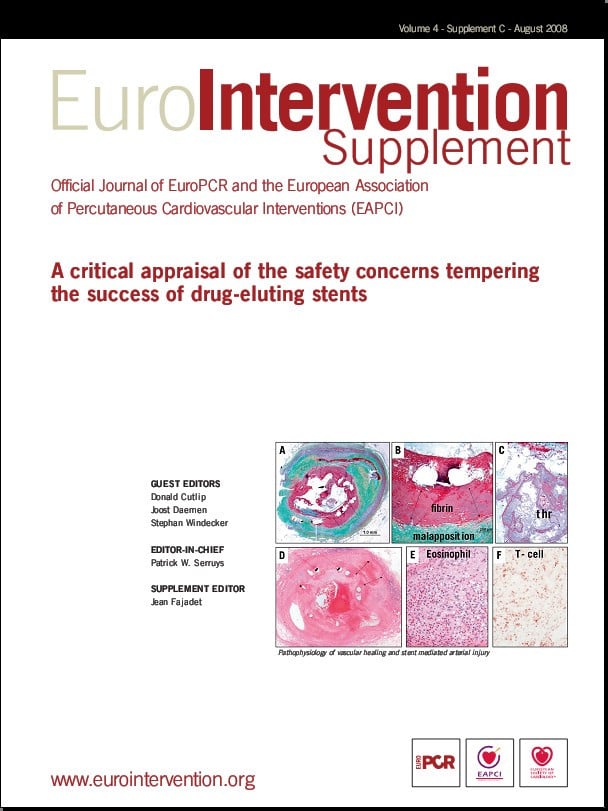Following in the memorable tradition of the previous EuroIntervention supplements on percutaneous valve replacement and cell therapy, it is a great pleasure to introduce this third EuroIntervention special edition entitled “A critical appraisal of the safety concerns tempering the success of drug-eluting stents”. This supplement is completely dedicated to current and future perspectives of stent thrombosis including: pathophysiology, imaging techniques, a critical appraisal of the ARC definitions, commentaries on currently available registry data, solutions for decreasing the rates of stent thrombosis and a critical comment on the cost-effectiveness of drug eluting stents (DES).
As with any new technology introduced into clinical practice, reports on side effects quickly followed the introduction of DES in 2002; as early as 2004, McFadden and colleagues reported in the Lancet on the first four cases of stent thrombosis (ST) in patients treated with DES discontinuing dual antiplatelet therapy. In the following years, the incidence of late ST was scrutinised by alerted clinicians in pivotal randomised controlled trials, small post-marketing surveillance trials and large-scale real world registries. While the accruing amount of reports provided more insight into the pathophysiology and risk factors for stent thrombosis, alarming data were presented at the European and World Congress of Cardiology in Barcelona 2006 on a worse long-term prognosis following DES implantation as compared to bare metal stents. As a result, both randomised controlled trials and registry data were scrutinised to validate these concerns, bearing in mind the differential values of both types of studies. To review the safety and efficacy of DES, the American Food and Drug Administration (FDA) even convened a panel meeting in December of 2006, in which experts from the throughout the world reviewed the DES safety concerns. The panel concluded that although there was a small but significant increase in the rates of late stent thrombosis, the use of DES remained effective and equally safe as compared to bare metal stents.
Approximately one year later the worldwide discussion on the long-term safety and efficacy of DES also triggered the European Society of Cardiology (ESC) in association with the European Association for Percutaneous Cardiovascular Interventions (EAPCI) to organise a forum on DES. On September 27 and 28, 2007, key opinion leaders in (interventional) cardiology and representatives from industry and regulatory bodies gathered in the European Heart House with the intention to review, not only the safety and efficacy of DES with more recent data, but more importantly the health economics, the DES registration process in Europe and current and possible future trial designs as well. The overall goal was to provide general recommendations to the medical community for the use, clinical development and future assessment of DES.
Soon after this European Heart House summit on DES, the idea arose to dedicate a complete supplement to the safety concerns tempering the success of DES. This is to function as an additional and complementary reference along with the official Taskforce meeting report (which will be published shortly in the European Heart Journal), the specificity of EuroIntervention and our supplement allowing us to cover a variety of safety concerns in a more detailed fashion than the report itself.
Stent thrombosis in particular has been linked to a wide variety of pathophysiological mechanisms and clinical and procedural risk factors. In the first part of this supplement Yakazama, van Werkum and Onuma will focus on three key elements in the process of stent thrombosis, namely the inflammatory and endothelial reaction of the tissue to the device and platelet reactivity as determined by several novel methods. Additionally, the ESC Taskforce committee concluded that DES market access should be partly based on a proper assessment of restenosis using imaging techniques which include intravascular ultrasound with additional assessment of neointima formation, stent coverage and endothelial function using techniques such as optical coherence tomography (OCT) and shear stress analysis. These methods will be reviewed in the second part of the supplement by Barlis, Wentzel and Garcia.
It has already been more than a year since the ARC definitions were published in Circulation by Cutlip et al in 2007. Despite the fact that these definitions have been adopted worldwide as an interesting tool to standardise the reporting of stent thrombosis, several issues remain and limitations arose during their use. In the third part of our current supplement, Vranckx et al provides a critical appraisal of the initial consensus document.
In the fourth part, several experts in the field re-assess the currently available registries reporting on the safety and efficacy of DES. Although these confirm the safety and efficacy of DES, there remains room for improvement. A wide variety of modifications to the stent platform, coating, drugs and eluting techniques are currently under investigation to tackle the current limitations of DES. In an attempt to develop more biocompatible stents facilitating adequate endothelialisation, Sprague, Scheller, Houtgraaf and ten Berg will address several novelties in the field.
Finally, it is clear that cost-effectiveness analyses are essential to fully understand the value of bare metal stents versus DES and enlighten our health care policies. Nevertheless, careful interpretation is needed when analysing specific patient subsets derived from clinical trials which might not reflect real world clinical practice. In this final part of the supplement Tony Gershlick will summarise the currently available data on cost-effectiveness of DES.
We hope that this supplement will act as a comprehensive and additional source of information on DES, providing insights to the concerns, as well as spotlighting possible solutions to the questions of safety surrounding drug eluting stents today.

